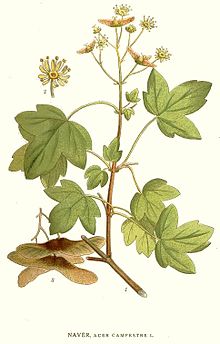field maple
Acer campestreDescription 7
Deciduous tree. Leaves 3-8 cm across, 5-lobed; lobes sometimes lobulate, obtuse or rounded, rarely acute; lobules obtuse, sinuses acute; base subcordate. Inflorescence corymbose. Samaras horizontal, often sigmoid along the back.
Acer campestre 8
Description[edit]
It is a deciduous tree reaching 15–25 metres (49–82 ft) tall, with a trunk up to 1 metre (3 ft 3 in) in diameter, with finely fissured, often somewhat corkybark. The shoots are brown, with dark brown winter buds. The leaves are in opposite pairs, 5–16 centimetres (2.0–6.3 in) long (including the 3–9 centimetres (1.2–3.5 in) petiole) and 5–10 centimetres (2.0–3.9 in) broad, with five blunt, rounded lobes with a smooth margin. Usually monoecious, the flowers are produced in spring at the same time as the leaves open, yellow-green, in erect clusters 4–6 centimetres (1.6–2.4 in) across, and are insect-pollinated. The fruit is a samara with two winged achenes aligned at 180°, each achene is 8–10 millimetres (0.31–0.39 in) wide, flat, with a 2 centimetres (0.79 in) wing.[6][7]
The two varieties, not accepted as distinct by all authorities, are:[4][6]
- A. campestre var. campestre - downy fruit
- A. campestre var. leiocarpum (Opiz) Wallr. (syn. A. campestre subsp. leiocarpum) - hairless fruit
The closely related Acer miyabei replaces it in eastern Asia.[6]
Ecology[edit]
Field maple is an intermediate species in the ecological succession of disturbed areas; it typically is not among the first trees to colonise a freshly disturbed area, but instead seeds in under the existing vegetation. It is very shade-tolerant during the initial stages of its life, but it has higher light requirements during its seed-bearing years. It exhibits rapid growth initially, but is eventually overtaken and replaced by other trees as the forest matures. It is most commonly found on neutral to alkaline soils, but more rarely on acidic soil.[9]
Diseases include a leaf spot fungus Didymosporina aceris, a mildewUncinula bicornis, a cankerNectria galligena, and verticillium wiltVerticillium alboatrum. The leaves are also sometimes damaged by gall mites in the genus Aceria, and the aphidPeriphyllus villosus.[13]
Cultivation[edit]
The field maple is widely grown as an ornamental tree in parks and large gardens. The wood is white, hard and strong, and used for furniture, flooring, wood turning and musical instruments,[14] though the small size of the tree and its relatively slow growth make it an unimportant wood.[6]
It is locally naturalised in parts of the United States[10] and more rarely in New Zealand.[15] The hybrid maple Acer × zoeschense has A. campestre as one of its parents.[7]
The tree has gained the Royal Horticultural Society's Award of Garden Merit.[16]
Cultivars[edit]
Over 30 cultivars of Acer campestre are known, selected for their foliage or habit, or occasionally both; several have been lost to cultivation.[17]
Bonsai[edit]
A. campestre (and the similar A. monspessulanum) are popular among bonsai enthusiasts. The dwarf cultivar 'Microphyllum' is especially useful in this regard. A. campestrebonsai have an appearance distinct from those selected from some other maples such as A. palmatum with more frilly, translucent, leaves. The shrubby habit and smallish leaves of A. campestre respond well to techniques encouraging ramification and leaf reduction.[18][19]References[edit]
- ^Stevens, P. F. (2001 onwards). Angiosperm Phylogeny Website Version 9, June 2008 [and more or less continuously updated since].
- ^L., Leinemann; Bendixen, Kathrin (1999). "Inheritance of isozyme variants in field maple (Acer campestre L.).". Forest Genetics 6: 73–77.
- ^"Acer campestre". Flora Europaea. Retrieved August 29, 2007.
- ^ abEuro+Med Plantbase Project: Acer campestre
- ^Flora of NW Europe: Acer campestre
- ^ abcdeRushforth, K. (1999). Trees of Britain and Europe. Collins ISBN 0-00-220013-9.
- ^ abcMitchell, A. F. (1974). A Field Guide to the Trees of Britain and Northern Europe. Collins ISBN 0-00-212035-6
- ^Den virtuella floran: Acer campestre distribution map
- ^ abNagy, L. & Ducci, F. (2004). EUFORGEN Technical guidelines for genetic conservation and use. Field maple Acer campestre. International Plant Genetic Resources Institute. Rome, Italy. Available online (pdf file).
- ^ ab"Acer campestre". USDA Plants Profile. Retrieved August 29, 2007.
- ^"Acer campestre". Ohio State University. Retrieved August 29, 2007.
- ^Department of Agriculture, Western Australia: Pests and Diseases Image Library
- ^Field maple images and diseases
- ^"Field maple_Woodland Trust".
- ^Trans. and Proc. Roy. Soc. New Zealand 36: 203-225 Plants naturalised in the County of Ashburton
- ^RHS Plant Selector Acer campestre AGM / RHS Gardening
- ^van Gelderen, C.J. & van Gelderen, D.M. (1999). Maples for Gardens: A Color Encyclopedia.
- ^"A. campestre". Bonsai Club International. Retrieved November 26, 2006.
- ^D'Cruz, Mark. "Ma-Ke Bonsai Care Guide for Acer campestre". Ma-Ke Bonsai. Retrieved April 15, 2011.
Sources and Credits
- (c) Peter O'Connor, some rights reserved (CC BY-SA), http://www.flickr.com/photos/58414938@N00/3830883078
- (c) anonymous, some rights reserved (CC BY-SA), https://upload.wikimedia.org/wikipedia/commons/thumb/6/68/Acer_campestre_JPG2.JPG/460px-Acer_campestre_JPG2.JPG
- (c) anonymous, some rights reserved (CC BY-SA), https://upload.wikimedia.org/wikipedia/commons/thumb/0/0d/Acer_campestris1.jpg/460px-Acer_campestris1.jpg
- (c) anonymous, some rights reserved (CC BY-SA), https://upload.wikimedia.org/wikipedia/commons/thumb/9/9f/Acer_campestre_003.jpg/460px-Acer_campestre_003.jpg
- (c) anonymous, some rights reserved (CC BY-SA), https://upload.wikimedia.org/wikipedia/commons/thumb/d/df/Acer_campestre_006.jpg/460px-Acer_campestre_006.jpg
- (c) anonymous, some rights reserved (CC BY-SA), https://upload.wikimedia.org/wikipedia/commons/thumb/c/c5/Acer_campestre_009.jpg/460px-Acer_campestre_009.jpg
- (c) Missouri Botanical Garden, 4344 Shaw Boulevard, St. Louis, MO, 63110 USA, some rights reserved (CC BY-NC-SA), http://eol.org/data_objects/4953598
- (c) Unknown, some rights reserved (CC BY-SA), http://eol.org/data_objects/31820028
More Info
- iNat taxon page
- African Plants - a photo guide
- Artdatabanken
- Biodiversity Heritage Library
- BOLD Systems BIN search
- Calflora
- CalPhotos
- eFloras.org
- Flora Digital de Portugal
- Flora of North America (beta)
- Global Biodiversity Information Facility (GBIF)
- Go Botany
- HOSTS - a Database of the World's Lepidopteran Hostplants
- IPNI (with links to POWO, WFO, and BHL)
- Jepson eFlora
- Maryland Biodiversity Project
- NatureServe Explorer 2.0
- NBN Atlas
- New Zealand Plant Conservation Network
- OregonFlora.org
- SEINet Symbiota portals
- Tropicos
- USDA PLANTS database
- VASCAN by Canadensys
- World Flora Online





























